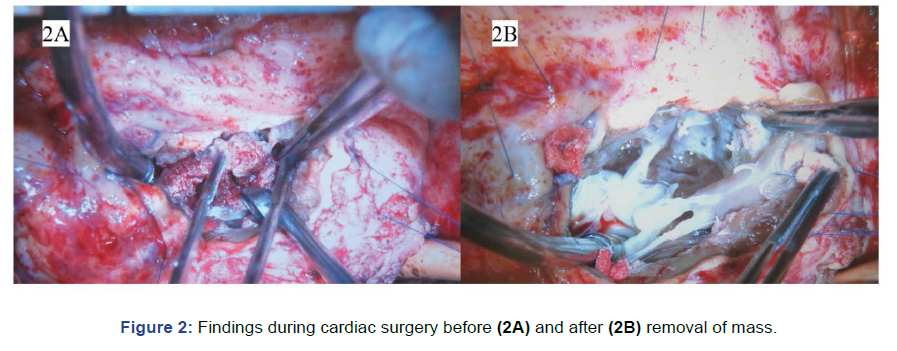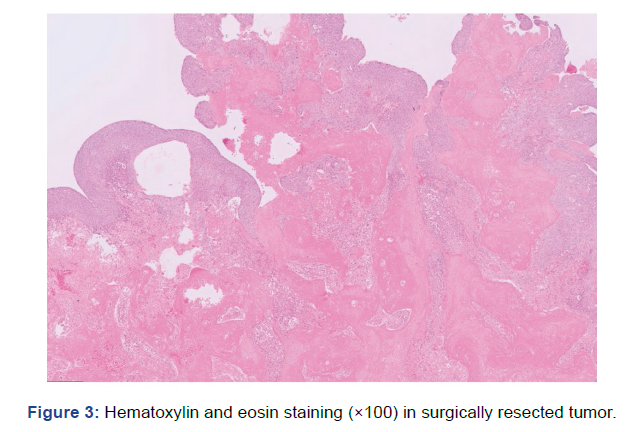Case Report - (2022) Volume 8, Issue 4
False-negative Findings for Cardiac Metastasis from Cervical Cancer on Fluorodeoxyglucose-Positron Emission Tomography/Computed Tomography
Tadaharu Nakasone*,
Yusuke Taira,
Tomoko Nakamoto,
Wataru Kudaka and
Yoichi Aoki
Department of Obstetrics and Gynecology, University of the Ryukyus, Japan
*Correspondence:
Tadaharu Nakasone, Department of Obstetrics and Gynecology, University of the Ryukyus,
207 Uehara Nishihara, Okinawa 903-0215,
Japan,
Tel: +81-98-895-1177,
Fax: +81-98-895-1426,
Email:
Received: 13-Apr-2022, Manuscript No. IPGOCR-22-12977;
Editor assigned: 14-Apr-2022, Pre QC No. IPGOCR-22-12977 (PQ);
Reviewed: 19-Apr-2022, QC No. IPGOCR-22-12977 (Q);
Revised: 22-Apr-2022, Manuscript No. IPGOCR-22-12977 (R);
Published:
29-Apr-2022, DOI: 10.21767/2471-8165.1000016.
Abstract
Background: Cardiac metastasis of cervical cancer is rare and has a poor prognosis. Some reports suggest that Positron Emission Tomography (PET) is useful in the diagnosis of cardiac metastasis. Case: A-40-year-old woman who had a history of cardiac surgery was treated with concurrent chemo-radiotherapy for stage IIIA cervical cancer (squamous cell carcinoma) and showed good response to treatment one year earlier. At 9 months post-treatment, Computed Tomography (CT) scan showed a thrombus in the left atrium, and the patient was started on warfarin. Three months later, a CT scan showed a mass in the right ventricle. PET scan showed no significant accumulation, and open heart surgery was performed with a preoperative diagnosis of thrombus. However, the postoperative pathological diagnosis was cardiac metastasis. Four months after the heart surgery, the tumor recurred in the right ventricle and embolized in the pulmonary artery, resulting in the patient’s death. Conclusion: In the diagnosis of cardiac metastases, PET may give false-negative results due to concomitant thrombosis.
Keywords
Cardiac metastasis; Cervical cancer
Introduction
Cardiac metastasis from cervical cancer is rare and has a
poor prognosis. Most cardiac malignancies are metastatic
tumors, but those of uterine origin are rare [1,2]. No specific
test can detect cardiac metastasis [1,2]. However, previous
studies reported that Fluorodeoxyglucose-Positron Emission
Tomography/Computed Tomography (FDG-PET/CT) is effective
in differentiating benign and malignant intracardiac tumors
[2-4]. In this case report, we describe a case of a right ventricular mass after radical radiotherapy for cervical cancer. After a
thorough examination, open heart surgery was performed with
a preoperative diagnosis of ventricular thrombus because PET
showed no significant accumulation, but the postoperative
pathological diagnosis was cardiac metastasis.
Case
The patient was diagnosed with cervical cancer stage IIIA
(Squamous Cell Carcinoma (SCC)) one year ago and underwent concurrent chemoradiotherapy. A 50 Gy dose of whole-pelvic
external beam radiation therapy was delivered in 25 fractions.
High-dose-rate intracavitary brachytherapy was delivered
once per week at a fractional dose of 6 Gy for three times at
point-A (total dose of 18 Gy). The combination chemotherapy
was administered at weekly CBDCA AUC2 considering the
cardiac burden caused by the infusion load during cisplatin
administration. The treatment effect was good, and no obvious
residuals were observed. Thus, regular follow-up was decided.
Three months ago, the possibility of a thrombus in the left
atrium was pointed out in a CT scan at follow-up. Warfarin was
administered, and the patient was under good control (PT-INR of approximately 3). This time, a follow-up CT scan showed
a mass in the right ventricle and enlarged mediastinal lymph
nodes. A PET scan showed significant FDG accumulation in the
mediastinal lymph nodes, suggesting lymph node metastasis,
but no accumulation in the intracardiac mass (Figure 1). Thus,
metastasis was ruled out for the intracardiac mass. With the
preoperative diagnosis of intracardiac thrombus, open heart
surgery was performed (Figure 2). The surgery was completed
without complication. Postoperative pathological examination
revealed SCC, and a diagnosis of cardiac metastasis was made
(Figure 3). One month after the operation, radiotherapy
for mediastinal lymph node metastasis was completed, but additional radiotherapy was performed because para-aortic
lymph node metastasis was found on CT scan 3 months after
the operation. Four months after surgery, the tumor recurred
in the right ventricle and embolized into the left pulmonary
artery, resulting in the patient’s death.

Figure 1: Intracardiac mass (red arrow) in computed tomography findings (1A) and no fluorodeoxyglucose (FDG) accumulation in positron emission tomography findings (1B).

Figure 2: Findings during cardiac surgery before (2A) and after (2B) removal of mass.

Figure 3: Hematoxylin and eosin staining (×100) in surgically resected tumor.
Discussion
In the case of cardiac metastasis, typical imaging findings may
not be obtained due to the presence of thrombus. Cardiac
metastasis from cervical cancer is rare. In a summary of
previous case reports (24 cases of cervical cancer with cardiac
metastasis) [5-7], the median age of the patients was 45.5
years (28-78), and the International Federation of Gynecology
and Obstetrics stage distribution was as follows: six patients in
stage IB, two in stage IIA, four in stage IIB, one in stage IIIA, six in
stage IIIB, and four in stage IVB. The histological types were SCC
in 22 cases and adenocarcinoma in one case. The median time
from initial treatment to cardiac metastasis was 11.5 months
(0-48), and the pathological diagnosis method was open heart
surgery in nine cases, autopsy in three cases, and biopsy in
nine cases. The median time from cardiac metastasis to death
was 5 months (1-13). The modality that contributed most to
the diagnosis of right ventricular metastasis was Magnetic
resonance imaging (MRI) in four cases, CT in four cases, MRI
combined with CT in three cases, and echocardiography in
three cases (n=14).
Given the poor prognosis, the ability to diagnose cardiac
metastasis preoperatively is important to determine the
indication for subsequent surgery. Recently, several reports have
shown that PET scan is useful in differentiating between benign
and malignant intracardiac tumors. In this case, the patient was
started on warfarin for left atrial thrombus for 3 months and
was under good control. In this respect, the environment was
thought to be less prone to thrombus formation. As a result,
the pathological findings were viable carcinoma: necrotic
tumor: fibrin = 1:5:4 (Figure 3). Moreover, the small amount
of viable carcinoma was thought to be the reason for the
lack of significant accumulation on PET. In a previous report
Saitoh Y, et al. [8], a thrombus was suspected based on MRI
signal intensity, but pathological examination revealed a tumor.
PET has been reported to be useful in the early detection of
thrombosis before clinical symptoms appear. Previously, FDG
was widely used to detect intravascular inflammatory lesions.
On the cellular level, thrombus formation begins with the
accumulation of inflammatory infiltrates, which leads to focally
increased FDG uptake, suggesting that FDG-PET/CT can be
used to detect venous thrombi [9]. PET appears to be useful in
the diagnosis of thrombus because it detects inflammation in
the vessel wall rather than thrombus accumulation. Although
there was no FDG accumulation in the intraventricular mass in
this study, some accumulation was observed in the ventricular
muscle, which suggested ventricular metastasis and thrombus
formation.
In lung cancer, the fact that colloid/mucinous/lepidic
adenocarcinomas have a remarkable tendency to generate false-negative PET findings [10]. Therefore, although the falsenegative
findings are not likely to be common in SCC of cervical
cancer, they should also be noted depending on the histology.
As mentioned previously, cardiac metastasis from cervical
cancer has a poor prognosis. Thus, preoperative diagnosis is
important in determining the indication for surgery. However, a
recent report Steely AM, et al. [11] showed that pembrolizumab
was very effective in the treatment of cardiac metastasis from
cervical cancer. Based on this case, it may be possible to
improve the prognosis of patients with cardiac metastasis by
performing surgery to prevent arterial embolization and heart
failure and by administering an immune checkpoint inhibitor as
an additional treatment.
Conclusion
In conclusion, in the diagnosis of cardiac metastases, PET may
give false-negative results due to concomitant thrombosis.
Author Contributions
The work presented here was carried out in collaboration
among all authors. TN wrote the manuscript. TN, YT, TN, WK
and YA are chief doctors and treat the patient.
Conflicts Of Interest
We have no conflict of interest to declare.
Declaration of Competing Interest
The authors declare that they have no known competing
financial interests or personal relationships that could have
appeared to influence the work reported in this paper.
Acknowledgment
The authors would like to thank Enago (www.enago.jp) for the
English language review of this article.
Teaching Points
In the diagnosis of cardiac metastases, PET may give false
negative results due to concomitant thrombosis.
REFERENCES
- Burazor I, Aviel-Ronen S, Imazio M, Goitein O, Perelman M, et al. (2018) Metastatic cardiac tumors: from clinical presentation through diagnosis to treatment. BMC Cancer 18(1): 202.
[Google Scholar], [Crossref], [Indexed at]
- Poterucha TJ, Kochav J, OconnorDS, Rosner GF (2019) Cardiac Tumors: Clinical Presentation, Diagnosis, and Management. Curr Treat Options Oncol 20(8): 66.
[Google Scholar], [Crossref], [Indexed at]
- Qin C, Shao F, Hu F, Song W, Song Y, et al. (2020) 18F-FDG PET/CT in diagnostic and prognostic evaluation of patients with cardiac masses: a retrospective study. Eur J Nuclear Medic Molecu Imaging 47(5): 1083-1093.
[Google Scholar], [Crossref], [Indexed at]
- Yin H, Mao W, Tan H, Zhu N, Wan Q, et al. (2021) Role of 18F-FDG PET/CT imaging in cardiac and pericardial masses. J Nucl Cardiol.
[Google Scholar], [Crossref], [Indexed at]
- Tsuchida K, Oike T, Ohtsuka T, Ide M, Takakusagi Y, et al. (2016) Solitary cardiac metastasis of uterine cervical cancer with antemortem diagnosis: A case report and literature review. Oncol Lett 11(5): 3337-3341.
[Google Scholar], [Crossref], [Indexed at]
- Byun SW, Park ST, Ki EY, Song H, Hong SS, et al. (2013) Intracardiac metastasis from known cervical cancer:a case report and literature review. World J Surg Oncol 11(1): 107.
[Google Scholar], [Crossref], [Indexed at]
- Sasidharan A, Hande V, Mahantshetty U, Shrivastava SK (2015) Cardiac metastasis in cervical cancer. BJR Case Rep 2(2): 20150300.
[Google Scholar], [Crossref], [Indexed at]
- Saitoh Y, Aota M, Koike H, Nakane T, Iwasa Y, et al. (2005) Isolated Right Ventricular Metastasis of Uterine Cervical Carcinoma. Jpn J Thorac Cardiovasc Surg 53(12): 645-648.
[Google Scholar], [Crossref]
- Kaghazchi F, Borja AJ, Hancin EC, Bhattaru A, Detchou DKE, et al. (2017) Venous thromboembolism detected by FDG-PET/CT in cancer patients: a common, yet life-threatening observation. Am J Nucl Med Mol Imaging 11(2): 99-106.
[Google Scholar], [Crossref], [Indexed at]
- Lococo F, Galeone C, Formisano D, Bellafiore S, Filice A, et al. (2016) 18F-fluorodeoxyglucose positron emission tomographic scan in solid-type p-stage-I pulmonary adenocarcinomas: what can produce false-negative results? Eur J Cardiothorac Surg 51(4): 667–673.
[Google Scholar], [Crossref], [Indexed at]
- Steely AM, Watkins AA, Vidal B, White D, Chu LM (2022) Pembrolizumab Improves Survival After Resection of Intra-cardiac Metastatic Cervical Carcinoma. Ann Thorac Surg.
[Google Scholar], [Crossref], [Indexed at]
Citation: Nakasone T, Taira Y, Nakamoto T, Kudaka W, Aoki Y (2022) False-negative Findings for Cardiac Metastasis from Cervical Cancer on Fluorodeoxyglucose-Positron Emission Tomography/Computed Tomography. Gynecol Obstet Case Rep. Vol.8 No.4:16. DOI: 10.21767/2471-8165.1000016.
Copyright: © 2022 Nakasone T, et al. This is an open-access article distributed under the terms of the Creative Commons Attribution License, which permits unrestricted use, distribution, and reproduction in any medium, provided the original author and source are credited.




